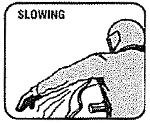Commonly Used Snowmobile Signs
Regulatory Signs

Trail Markers, Information, and Destination Signs

Caution Signs

Hand Signals

Left Turn
Left-arm extended straight out from the shoulder and pointing in the direction of the turn.

Right Turn
Left-arm raised at shoulder height, elbow bent, and forearm vertical with palm of hand flat.

Stop
Left or Right arm raised from the shoulder and extended straight up over the head with the palm of hand flat.

Slowing
Left arm extended out and down from the side of the body with a downward flapping motion of hand to signal warning or caution.

Oncoming Sleds
Left arm raised at shoulder height, elbow bent and forearm vertical, wrist bent, move the arm from left to right overhead, pointing to the right side of the trail.

Sleds Following
Arm raised, elbow bent with the thumb pointing backward, in “hitch-hiking” motion, move the arm forward to backward over your shoulder.

Last Sled in Line
Raise forearm from the handlebar and show clenched fist at shoulder height.
Snoman Code of Ethics
I understand and accept the risks associated with snowmobiling and I will take responsibility for my own actions...
As a responsible snowmobiler...
- I will ride in a manner that is a credit to our recreation.
- I will influence other snowmobilers to adhere to this Code of Ethics.
- I will respect the rights of others including property owners and other outdoor enthusiasts.
- I will protect our natural environment.
- I will ride in a responsible manner and will use only marked trails, areas or roads open to snowmobilers.
- I will not harass or harm wildlife or the natural surroundings.
- I will minimize my impact on the environment.
- I will ride smart, be prepared and stay in control.
- I will check ice and weather conditions before riding.
- I will help those in distress.
- I will obey all laws and rules governing our recreation.
- I will promote proper snowmobile education and training.
- I will practice Zero Tolerance with respect to impaired driving.
Be Responsible
While riding please respect private landowners and stay on the designated trail. Respect Registered Trappers Blue Ribbon Trails. Respect farmers as they may have forage or winter crops planted. Always approach riders that are on horseback carefully as not to scare the animals Respect Wildlife.
Facts About Snowmobiling and the Environment
Canadian Council of Snowmobile Organizations provides the following facts as counterpoints to the many myths and misconceptions about snowmobiling and the environment.
- Snowmobiling occurs in defined locations, such as organized trails and designated riding areas.
- The total surface footprint of all snowmobile trails in Canada equals approximately 240 square miles, about the size of a medium-sized town.
- Because snowmobiling occurs in this comparatively small footprint, the interaction between snowmobilers and wildlife remains minimal.
- Snowmobiling occurs when a blanket of snow protects the ground, thereby minimizing its impact on plants and the earth.
- After the snow melts, nature flourishes again, including where sleds have traveled.
- Today's snowmobiles are built 94% quieter than early sleds and when left in stock condition, produce a minimal sound level as certified by professional engineers.
- Overall, snowmobiles account for a small fraction of all the motor fuel burned annually in Canada.
- Today's snowmobiles use significantly less fuel and oil and run much more efficiently than older sleds.
- Today's snowmobile engines produce 98% fewer hydrocarbons than older sleds.
For more information go to www.ccso-ccom.ca
Snowmobilers Care About Our Environment
For more than 40 years, snowmobilers have acted as environmental stewards, doing our part to keep nature beautiful. Today, responsible riding is more important than ever, so Snoman Inc. encourages snowmobilers to continue to:
Stay On The Trail
Whenever possible, reduce your environmental footprint by riding on organized snowmobile trails, which act as defined corridors to move sleds along with the minimal impact on nature.
Respect Sensitive Areas
It is important to stay on trails in areas marked as environmentally sensitive or protected habitats.
Leave Tracks, Not Trash
If you had space to bring it in, then respect nature by carrying litter out with you. This includes sled parts, such as broken belts, oil containers, used spark plugs, food, cans, etc.
Spread the Word
Snowmobiling and the environment is a good news story. Snowmobilers are proud of their stewardship contributions and the CCSO encourages every rider to spread the word about our progress in keeping nature beautiful.
Embrace New Technologies
Today's clean and advanced technology, snowmobiles run even more efficiently, effectively, and much quieter too. They also benefit Mother Nature by significantly reducing emissions and virtually eliminating smoke and smell.
Maintain Your Sled
A well-tuned snowmobile is more environmentally friendly, efficient, and reliable, so be sure your sled is in tip-top shape before each ride.
Protect Wildlife
Keep your distance and leave wildlife alone, allowing them to move away from you at their own pace. Avoid riding in areas reserved for endangered species.
Keep It Quiet
Refrain from replacing the manufacturer's certified and approved muffler with noisy after-market pipes that may disturb wildlife, increase emissions and annoy others.
February is National Snowmobiling Environment Month












